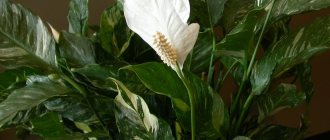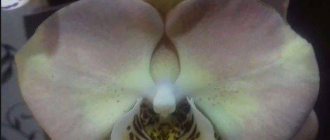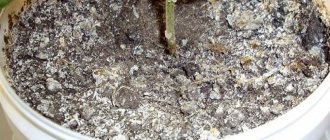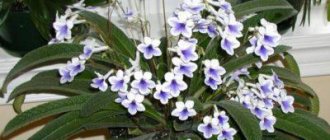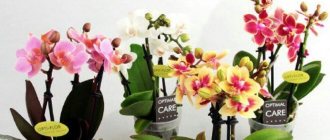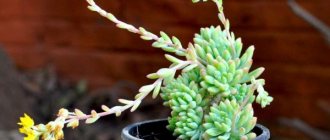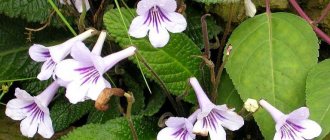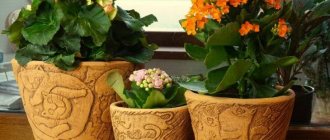Spathiphyllum is especially popular in Russia; people call it “women’s happiness.” More than 40 species and varieties of this plant are known. They belong to the Araceae family, perennial, herbaceous. Most of the specimens presented in stores are hybrids. The color of some varieties is very unusual, these include Spathiphyllum Angel Baby, Lemon Glow and others. Hobbyists collect a whole collection of these indoor plants; they fit well into the interior, have large decorative leaves, refresh the room and are easy to care for.
Spathiphyllum: about the plant
Spathiphyllum was brought to Europe in the 19th century, its homeland is Colombia and Ecuador. The first breeding of spathiphyllums was carried out by the German botanist Wallis, and one of the plant species was named after him. The name itself translates as “leaf-spread”, given because of the large wide bracts.
This evergreen plant has beautiful white cupped flowers . There are giant spathiphyllums (height reaches 1.5 meters), medium ones (up to 80 cm) and dwarfs (30-35 cm). Structure:
- roots are short;
- there is no stem, the leaves grow directly from the ground;
- leaves are oval or oblong, lancet-shaped, the central vein is clearly defined, the lateral veins are thin, the petiole is long;
- the peduncle is equal in height to the petiole or greater than it;
- the inflorescence is dense, wrapped in a blanket;
- a blanket in the shape of an ellipse, white or greenish;
- seeds are curved, sweetish.
In nature, plants choose areas near water bodies and swampy forests. Spathiphyllum is propagated by dividing the bush during spring replanting. Another option is cuttings. Seeds are rarely used for these purposes.
There is a belief connected with spathiphyllum: if on a bush , it means that the owner will soon have a new addition to her family or the appearance of a lover.
Announcements on NN.RU – House
Professional repair of household appliances at home.
We repair any DVRs: Neoline, Kapkam, Playme, Sho-Me, Mio and others. The service center is located near you! Can. Price: 300 rub.
We repair any MFP: HP, Epson, Canon, Samsung and others. The service center is located near you! We can repair any.
We repair any monitors: Asus, Samsung, Benq, ViewSonic and others. The service center is located near you! We can repair it. Price: 300 rub.
More than 200 people - social activists, volunteers, volunteers of search and rescue teams - were nominated for an award.
A new art object has appeared in Nizhny Novgorod. Street artist Elena Lisitsa placed the Wheel of Fortune on Shevchenko Street, 17. We asked around.
Repair is a real challenge for a family. A hundred questions arise that have no answers, and a lot of problems that are urgently needed.
The Ministry of Emergency Situations reports the crash of an aircraft in Gorodets, Nizhny Novgorod region. The incident happened last night: during a hard landing.
Spathiphyllum is a houseplant that has spectacular and beautiful flowers. Belongs to the aroid family. In nature, there are plants of different heights, leaf shades and flower shapes. If you care for it correctly, the flowering will be beautiful and long-lasting. But before you start caring for this amazing crop, you should decide on the choice of species. This article presents ornamental crops for growing at home.
Variety of species and varieties of spathiphyllum
According to the types and varieties, spathiphyllum can be divided into groups according to the table:
| Features | Unusual (differ in shape, leaf ) | Easy to care for, for beginners in floriculture | Expensive varieties | Difficult to care for | Rare | High |
| Name Spathiphyllum | Silver Rain dwarf, Domino | Angel Baby, Spilt Milk, Mauna Loa, Wallisii | Sunny Sails yellow, white, Delhi, Sensation | Spoon-shaped (Cochlearispathum), Abundantly flowering regular and mini (Floribundum, mini), Picasso (Picasso) | Lemon Glow, New One | Spoon-shaped (Cochlearispathum), New One (New One) |
The abundance of spathiphyllum varieties allows you to choose the most attractive ones in terms of color, size and labor intensity of cultivation.
Spathiphyllum varieties with unusual leaf colors
The dense, dark green leaves of the plant do not always come in the same shade. Fancy colors attract attention against the background of other home greens and make spathiphyllum unusually beautiful. Fans of indoor floriculture are hunting for these varieties:
- Spathiphyllum Angel Baby leaves are long and thin. They have stripes of white and pale green;
- in the Domino variety, the leaf blade is covered with small light spots on a dark green background, as if paint had been splashed on the plant;
- spathiphyllum variety Lemon Glow has bright greenish-yellow leaves;
- Kaiti has soft leaves with yellowish spots;
- Gemini has large leaves with uneven inclusions in the direction of growth of the lateral veins. The bush looks unusual, because the spots are of different sizes;
- spathiphyllum variety (Spilt Milk) has matte leaves that are pale green, almost white;
- unusual oblong leaves of City of Angel spathiphyllum are almost white, with green speckles;
- Due to low demand, the Picasso variety was temporarily stopped exporting. The color of the plant is similar to the landscapes of the artist in whose honor it was named: in one area the dark green leaf is covered with small, thin light strokes, in the other large white and green spots alternate. The flower's veil also has a heterogeneous green-white color;
- The leaf blades of Spathiphyllum Black Beauty have a dark, rich green, almost black color.
Plants of this genus are mostly unpretentious, but there are growing nuances that must be taken into account.
How to care for spathiphyllum
The flower loves warmth, it does not have a rest period, so it is necessary to maintain the temperature regime all year round. In winter it is at least 16 degrees. The plant is native to the tropics and is accustomed to a humid and sunny climate. You will need a lot of light; it is advisable to keep spathiphyllum on an open windowsill. Periodically, the pot needs to be rotated around its axis so that the leaves do not tilt toward the ultraviolet source. If there is not enough light, the plant will not bloom.
If the flowers have faded, they must be removed, and the same is done with old leaves. Periodically wipe the plant with a damp cloth.
To make spathiphyllum feel comfortable, it is planted in a mixture of:
- peat;
- leaf humus;
- river sand or perlite;
- pieces of pine bark;
- charcoal.
Reproduction methods
Spathiphyllum is easy to grow - buy or receive as a gift. And even easier to breed. Choose: by seeds, cuttings or dividing the bush.
propagation of spathiphyllum by cuttings
To do this, cut the leaf rosette from the carrier and place it in water until roots form. You can immediately plant it in perlite and cover it with a glass container.
Root formation is promoted by activated carbon added to water.
propagation of spathiphyllum by division
The easiest way. It is recommended to carry out in early spring. The procedure is very useful - it allows you to thin out the bush. Which will lead to increased growth.
The material is ready for planting immediately after division. A twig with at least three leaf rosettes is guaranteed to take root.
The rules for planting a separated part are the same as the general ones for transplanting.
The soil should be slightly acidic.
Feed the flower with special fertilizers every 14 days. In winter, this can be neglected, since spathiphyllum grows more slowly.
Air humidity should be high, so use a humidifier and spray the leaves with water when watering. Watering is required infrequently, 1-2 times a week; there is a high risk of flooding the plant, especially in the winter months. Spathiphyllum does not tolerate drafts.
The bush needs to be replanted once every 2 years, but it can be propagated by division. It is carried out in the spring, without waiting for the flowers to appear. If the roots have not grown and the plant does not feel discomfort, then the procedure can be postponed. Rules for replanting a plant:
- The spathiphyllum pot must have drainage holes.
- Drainage should be poured into the bottom (expanded clay, broken brick or clay shards).
- Sprinkle with a small amount of substrate.
- Spread the roots of the flower and place in the center of the pot, sprinkle with soil.
- Fill the pot completely and press the soil a little with your fingers; there should be 1-2 cm left to the edge of the pot.
After transplanting, place the flower in a dark place and do not water it for 3-4 days.
Diseases and pests, means of combating them
The plant is very often susceptible to diseases if not properly cared for. The most common problems include:
- yellowing of leaves - such symptoms may indicate a lack of moisture; to eliminate this, you need to water the plant and spray the leaves every few days;
- the leaves turn black - this problem occurs when the root system is diseased. In such cases, the plant must be transplanted to a new place of growth and the root must be carefully examined. Rotten and damaged areas must be removed;
- leaves curl - such symptoms indicate dry air in the room and excessive amounts of sunlight. The plant needs to be shaded.
In some cases, pests can be seen on the plant. At the first symptoms, measures should be taken, otherwise the plant may die. The most common pests on indoor plants are:
- aphids - feed on plant sap. To combat it, you need to wipe the leaves with a soapy solution;
- spider mite - forms small tubercles on leaves and shoots, the pest destroys the leaves and leads to the death of the flower. To fight, you need to use onion infusion or soapy water.
To prevent the appearance of diseases and pests, it is necessary to follow the rules of care and add nutrients in a timely manner.
Spathiphyllum is often used to decorate rooms. The variety Sweet Chico is a prominent representative of the species. Cultivation involves following fairly simple care rules; the flower itself grows quickly and has an attractive appearance.
The most common disease of Spathiphyllum is rot. If a plant is infected with rot from the base, the symptoms appear in hard-to-reach places, so it is not possible to detect it in time. Subsequently, the disease spreads upward, the disease covers the leaves, which turn yellow and dry out.
Sometimes the disease affects only one part of the plant, while the second continues to turn green. It is important to detect the disease as early as possible so that it does not spread to the roots. The reason for the formation of rot is planting the plant in slightly acidic soil, as well as abundant watering. When affected by rot, the roots become covered with scales and soften.
Late blight also appears from the roots. The disease forms on the root collar of the flower and goes to the top, affecting an increasingly larger surface of the flower. This disease is caused by a fungus that grows in waterlogged soil.
Very often spathiphyllum is attacked by pests. When small yellow spots appear on the foliage, which subsequently become discolored and begin to dry out, this indicates the presence of spider mites. It usually lives on the underside of leaves. The reason for its appearance is too high a temperature and dry air in the room.
Aphids are another pest that affects “women’s happiness.” Aphids live on the lower part of the leaf. You can fight it with a soap solution or nicotine sulfate diluted in water.
Dark spots appearing on the stems and leaves indicate a scale insect attack. They fight it with a mixture of tobacco and soap and water.
When a plant is affected by rot from the rhizome, it is unlikely to be saved.
Therapeutic measures aimed at combating late blight are useless. The affected flower must be destroyed to prevent the development of the disease. Then treat all plants located in the same room with the affected flower.
